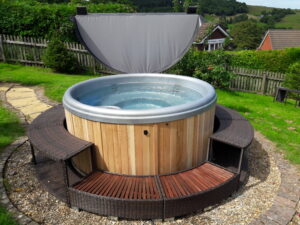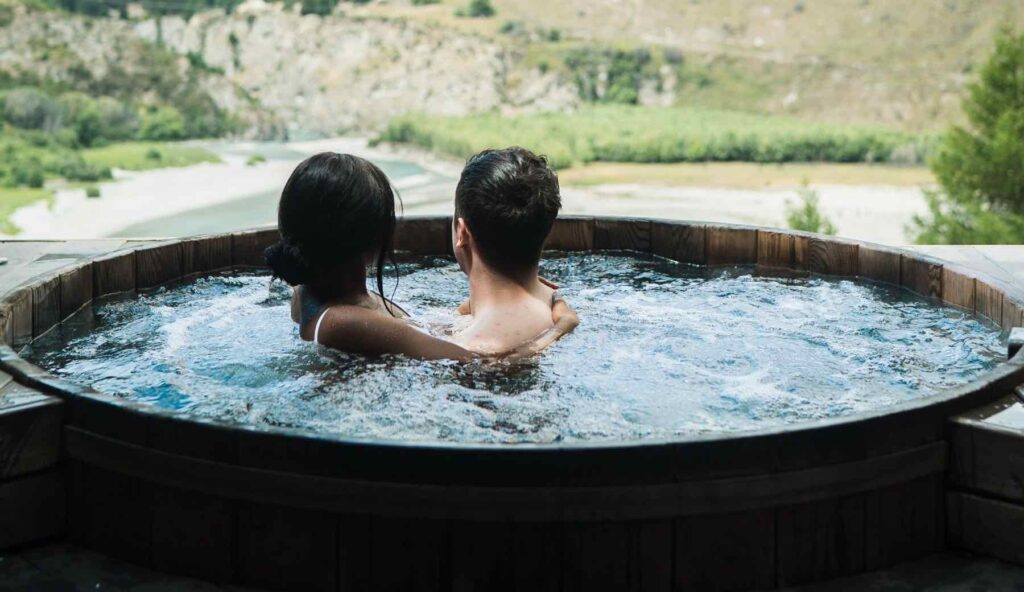If you’re thinking of buying a hot tub, chances are you’ve been doing a bit of research into the types available. With the current energy crisis, it’s also possible that you’ve added a wood-fired tub to your shortlist, or are at least considering one as a potentially lower-running-cost option.
So, with that in mind, should you buy a wood-fired hot tub for your home or holiday cottage?
Well, before taking the plunge, there are a few things to consider before deciding whether a log burning hot tub is right for you.
Full disclosure – ultimately, we believe these hot tubs are only really suitable for a very narrow set of criteria. The likelihood is if you’re shopping for a home spa, but are worried about energy costs, with all other criteria considered you’ll do better choosing an energy-rated fully insulated electric-powered tub from a trusted manufacturer.
That said, if you have your heart set on a wood-fired tub, let’s take a look at the pros and cons, and when they may (or may not) be right for you. We’ll be answering common questions below, such as how do wood-fired tubs compare with standard electric hot tubs, are they any good and are wood-fired tubs easy to maintain?
But first, let’s look at how you’re planning to use your hot tub.
Home or holiday let?
Running a business versus buying a hot tub for home use will affect which types are most suitable for you, but a lot of the basic queries will be similar. Whether you’re looking for personal use or for your business, when you’re shopping around for a hot tub, the likelihood is you’ll want something that fits the following criteria:
- Is safe
- Is convenient and easy to use
- Has a low running cost
- Is reliable
- Is built to last
- Fulfils other requirements such as hydrotherapy, seating, look and feel, etc
For holiday cottages or lets, there’s also one additional criteria:
- Is going to attract bookings
Let’s look at these one by one.
Safety
Are wood-fired hot tubs safe? Well, the short answer is yes – if all of the instructions are followed. Many people buy and use wood-fired hot tubs without incident. However, there are a lot of areas to consider when it comes to any hot tub, and these can be a bit more complex with a wood-fired tub, including the following:
- Water hygiene and bacterial growth
- Water temperature
- Temperature of external elements and components
This is why there are very strict criteria around how log-burning hot tubs are used and managed, especially in a business setting. So, to really look at the issue of safety, we also have to combine it with this set of criteria. Which leads us nicely into…
Convenience and ease of use: health and safety
First things first, when it comes to business setting such as holiday lets, BISHTA has a few things to say about wood-fired tubs, most notably:
‘…wood-fired (Scandinavian-type) hot tubs … are not considered suitable for “business settings” (e.g. holiday parks and rentals) unless they are going to be drained and cleaned at least every 3 to 5 hours, depending on the water source used.’
Let’s look at our list of considerations one by one:
Water hygiene and bacterial growth
While electric hot tubs come equipped with a circulation and filtration system to tackle debris and pollution, as well as a chemical treatments to disinfect the water, the log burning hot tubs do not. As noted in the BISHTA article, this means failure to change the water every few hours – and between every use – could result in nasties such as rapid bacterial growth, putting users at risk of infection.
Water temperature
Most electric hot tubs come with a temperature gauge and built-in thermostat to help you to measure the temperature and keep it constant and safe. If it does get too hot, then it will alert you so you can address the issue. With a wood-fired hot tub, there’s none of the above. While a log-burner certainly has a rustic appeal, it’s a lot harder to control the temperature and any readings will have to be taken manually using a floating thermometer. This increases the risk of scalding or other heat-related health and safety issues – especially for children or those who are pregnant.
According to BISHTA, this is one of the reasons why wood-fired hot tub are not covered in the HSG 282 guidance.
Temperature of external elements and components
It’s not just the water that poses a temperature risk – exposed metal elements, such as the chimney or near the log burner, can get extremely hot, posing a further risk to guests – especially if small children are present.
In terms of safety and more detailed guidance for wood-fired hot tub for business use (or even if you’re considering it for personal use), the full BISHTA piece is worth a read.
Convenience and ease of use: heating time
Another thing to consider aside from the health and safety elements, is that you’ll need to fill and heat the tub from scratch every time you use it. Wood-fired hot tubs are often billed as having a quicker heating time than their electric counterparts. This may technically be true if you’re heating the water from scratch every time – as you have to do with a wood-fired tub – but is in actual fact a little misleading as this is not how electric hot tubs are used. Instead, with an electricity powered tub the water is kept at a consistent temperature, with the foam insulation and cover keeping the heat in for energy efficiency, so it’s ready to use as and when you need it. If you don’t want to have to plan a few hours in advance every time you want to take a dip, then an electric tub is going to be better suited for your needs.
Running costs
If you don’t find the upkeep required to have a safe wood-fired hot tub too daunting, then it’s true that you’ll save on electricity costs, but you will still need to pay for the firewood every time it’s used. And remember that while an electric hot tub is kept at a consistent temperature, you’ll need to heat the water from scratch every time, which could use a considerable amount of fuel – especially on a cold day. If you’re running a holiday let, you’ll also have to drain the tub after each use, increasing the amount of water used. And it’s also worth factoring in the staffing costs that may come with the increased upkeep of a log-burning tub, such as regular filling, draining and cleaning, lighting the fires, supplying the firewood and so on.
Reliability
As an electric hot tub has mechanical parts such as a pump, circulation system jets, control panel, and, in many cases, music and lights, there’s more that can go wrong, so breakdowns can and will happen over the course of a tub’s lifetime. However, with proper care and maintenance, these can be kept to a minimum – and your dealer should be on hand to fix any issues as and when they arise. With a wood-fired hot tub, there’s far less to go wrong as there’s not that much to them.
However, in terms of use there are a few hurdles you’ll encounter. The first is getting the fire lit in the first place – particularly if the weather is windy or rainy. The second is reliability of the experience. A wood-fired hot tub can’t be pre-heated, so bathing will need to be planned, and it can take several hours to heat the water (provided you can get a fire lit). After that, it’s a case of hoping it maintains a safe temperature, as any dips or increases will need to be watched and dealt with manually.
Build quality
If you choose a quality manufacturer, take care of your hot tub with regular servicing and maintenance, and follow instructions, then your electric hot tub should last you for many years. The same applies to wood-fired hot tubs: if you take care of them, then they should last. Many manufacturers claim a log-burning tub could last a lifetime. However, much like with electric tubs, warranties tend to be around five years in total.
The experience: jets, seating, look and feel, etc
Wood-fired hot tubs certainly have a rustic appeal. The natural cedar wood frames and log-burner-powered warmth will provide a soothing experience, with many people choosing them for the feeling of being closer to nature.
That’s not to say an electric hot tub won’t also provide a natural experience, but it might not have the stripped-back rustic charm of a log-burner powered tub. If it’s the look and feel of a cedar tub you’re looking for, though, then there are electric designs that will suit your needs, such as the Ystwyth Cedar tub from our Afon Range.

Beyond that, electric-powered hot tubs have a lot more to offer. If you’re looking for hydrotherapy and tailored massages, then a good-quality electric tub will most likely be the best choice, as the vast majority of wood-fired tubs don’t come with jets of any kind. The best-quality electric tubs are made with ergonomics in mind, so you can get the best massage for you. Likewise, if you want lighting, music packages or any other added extras, then an electric tub is the way forward. In terms of comfort, then on many models you’ll also get extras that aren’t standard on the more rustic wood-fired tubs such as loungers, neck pillows and drinks holders.
If convenience is a big factor, then everything from the filtration system to electric heating, and the fact that you don’t have to drain it down after each use will make an electric hot tub a much easier choice for most households and holiday cottages.
Holiday lets: will it attract booking?
Again, the short answer is yes. But then so will an electric hot tub. And, as the upkeep for an electric tub is a lot easier, and the waiting time for use a lot shorter, then a good-quality electric tub is likely to be a far more convenient choice for you and your guests.
The bottom line
In terms of the bathing experience, as always with buying a hot tub, it comes down to your ‘why’. If you’re looking for a back-to-nature, rustic experience, are comfortable with the required upkeep and don’t mind planning ahead for when you want to use your hot tub, then a wood-fired one may be right for you. If, on the other hand, you want a more luxury experience, as well as convenience, broader choice of styles or a tailored hydrotherapy option, then an electric tub will be the way forward.
For more information or advice on buying a hot tub, or to book a showroom visit, contact us online or give us a call on 01974 241 642.




